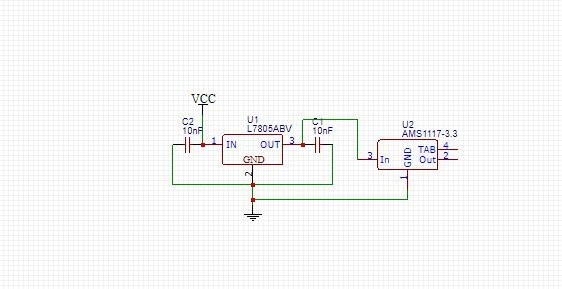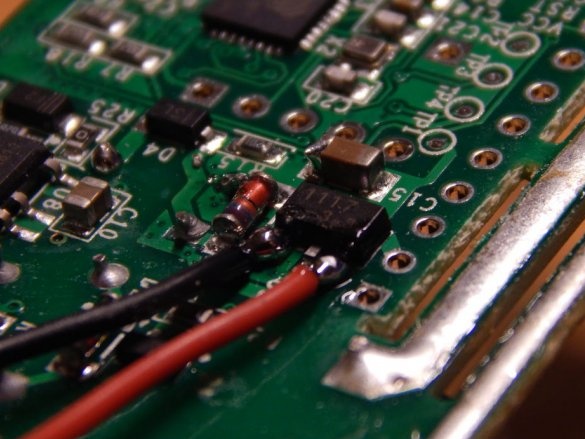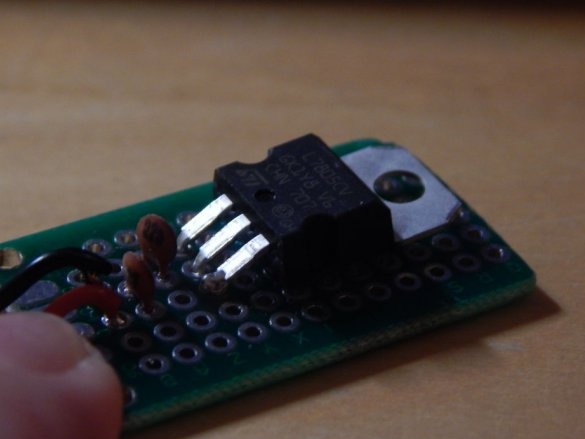Sonoff Basic WiFi Switch is designed for switching loads powered by 220V AC. So that he can switch loads powered by a constant voltage of 12V and feed on the same voltage himself, the author of Instructables, using the nickname idIoT3D, installed an additional stabilizer inside him on only three parts: one microcircuit and two capacitors. Performed on a small piece of the breadboard, the stabilizer fits easily into the device and connects to its main board with four wires.
Before starting work, the master takes a linear five-volt stabilizer of type 7805 (looks like a transistor, but is actually a three-pin analog microcircuit), two ceramic capacitors with a capacity of 10 nF (they are non-polar, and in the case of SMD-version they are printed with a number 103), a small piece of the breadboard, soldering iron, solder, flux, rosin and wires. From the switch, which has expired the guarantee, and to the input and output of which nothing is connected, he removes the housing cover. The warranty sticker is now damaged, but it already did not work.
Pulling the board out of the device’s case, idIoT3D finds on it an existing linear 3.3V stabilizer of the AMS1117-3.3 type (this is also a microcircuit that looks like a transistor, only smaller) and solders the wires to its first and third terminals, as shown in the photo below. In this case, they are not required to be soldered from the board, now they are connected to both printed conductors and new wires. The rest of the outputs of the regular stabilizer remain connected only to the board, you do not need to solder the wires to them.
The master solders two more wires to the input terminals of the switch. At the same time, they remain connected via relay to the output terminals. But the conductors going from the input terminals to the step-down transformer located on the board, idIoT3D cuts so that it does not unnecessarily load the 12V source with its active resistance.
Then, on a piece of the breadboard, the master assembles a new stabilizer from the 7805 chip and two capacitors according to the scheme.The four wires that idIoT3D previously soldered to the main board, it connects to the additional according to the same scheme.

This is how an additional stabilizer looks after manufacturing, but before connecting to some of the circuits of the main board:
He isolates the new board from the main one and places it so that the housing cover does not press on it. Then closes the lid. After completing the assembly of the case, he puts on the WiFi switch a marking of the polarity of the input and output, as shown in the KDPV. But he did not do it right. In addition to the polarity, compliance with which is now mandatory, instead of the incomprehensible word to the uninitiated hacked, we must also write that the device can only be powered with a constant voltage of 12V. Otherwise, someone will connect it to the network, as is usually done with similar switches, and will disable both the device itself and the load if a relay trips from such bullying. Do you need it?
From the software point of view, nothing has changed in the device - only from the hardware one. Additionally, you won’t need to reflash or reconfigure anything in it if it is already configured as you need. The WiFi switch will interact with your smartphone in the same way as before the alteration.
Note that the current switched by the relay contacts of the device remains the same, and as the voltage decreases, the load power that it can control also becomes much less. It was possible up to 2200W, it became up to 120, and then if the load is active. With an inductive load, you now need a diode in reverse polarity parallel to the output. If you are a bore, then at a constant, the permissible current through the relay contacts is even slightly less, which further reduces the maximum load power.



